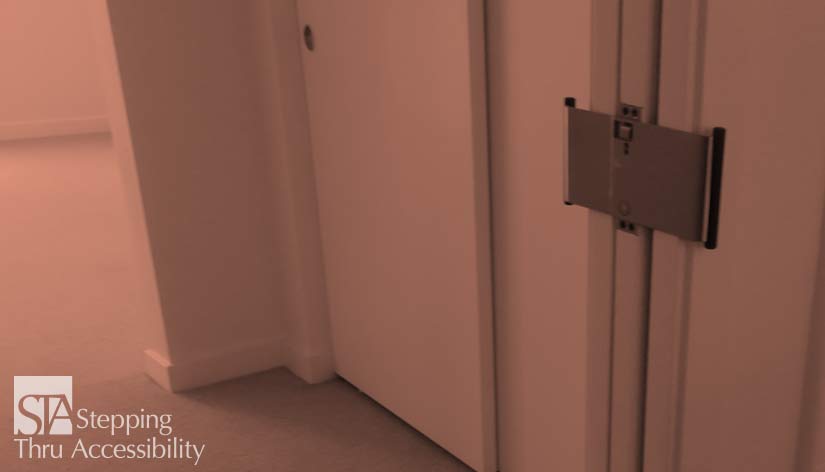Blog
Return to Blog »
Janis Kent, FAIA, Architect, CASp © April, 2019 Closet space, whether common shared storage for employees, or within mobility feature guest rooms in hotels, student housing, or public dwelling units, needs to be accessible under the ADA. What is required is – one of each type of storage in each area to be within reach range from a level clear floor space and along an accessible route. If the space has multi-bedrooms and bathrooms where only one might need to be accessible, for the most part, other closets in the unit will still need to meet this criteria. But what makes a closet accessible? If it is a walk-in closet in a mobility feature dwelling unit in public multi-family housing, since all spaces within the unit are to be accessible, the door is to have the required clearances on both sides, and the closet should have a turning space even if it is off of a sleeping room that is not designated accessible. This does not mean, though, one is required to provide walk-in closets. If it is a closet with a hang rod, it does not mean that the full length of the hang rod needs to be accessible, but rather a portion of it. The same is true for shelves where one shelf minimum or a portion of one shelf is to be within reach range. If the closet has racks or coat hooks then one minimum of each type is to be within reach range. I too often see the full length of the hang rod lowered. Think. If a space is shared between someone who is able-bodied and someone who uses a mobility device or short of stature, then both need to have storage at an appropriate height. There is no stipulation on how much is to be accessible – just one of each kind. So this is a judgement call. If the closet has a swinging or folding door where you reach from outside of the closet, then the storage needs to be within side reach range. For side reach, you can reach up to 48” AFF if located 10″ maximum deep, or 46″ AFF if 24″ maximum. This depth would be measured from the face of the door if it swings back 180° which means that by the time you count the door thickness or the casing, and the wall thickness, at 48″ AFF, you may only be able to reach into the closet about 1″ to 2″. You could reach 15″ to 16″ back if the element is at 46″ AFF. This would be a very shallow closet in order to meet access requirements. In order to reach further back you will need a front approach. The door should provide 32” minimum clear. If the depth you want to reach is more than 24” deep from the outside, then the clear width might be better if increased to 36” minimum. A front approach is also needed if the accessible portion extends around on the sides of the door opening. Another issue I have come across with sliding doors is recessed cups placed on the door in place of pull hardware. These are a very shallow recess – about ¼” to ⅜” and are not easy to use. The door also needs to have the hardware exposed when in the open and closed position in order to operate. Instead of the recessed cups consider a flange that is attached to the end of the door and protrudes out beyond the door face. If a washer and dryer are required to be accessible and located in a closet, the opening should be designed to be wide enough that the door/opening casing is located 24” minimum from the centerline of each machine. This would typically be about a 78” wide opening. More often than not, I am seeing minimal width closets of 64” clear. The intent is to have the doors removed and the machines pulled out to be flush with the casing to meet the 48” clear floor space centered on each machine for parallel approach. This is really not the best solution, particularly if located off of a living area – it might be a solution for existing construction but not new. And in this situation you may want to consider bi-fold doors. There are other types of storage to consider. This can include storage holders for an iron or a built-in safe in a guest room, a linen or front door closet in a residence, built-in shelves and drawers, or bike storage. Kitchen storage with built-in cooking elements do have different criteria. But counters with storage and a sink/refrigerator with no built-in cooking elements, such as in an employee lounge, do not need to meet the kitchen storage requirements, although they will still need to provide one of each type of storage accessible at a minimum. There are most likely other types of storage that I have not mentioned. Just remember, one of each type in each area is to be accessible. Be aware that your local City or County may have additional requirements that are more restrictive than the State or Federal requirements. Also, this article is an interpretation and opinion of the writer. It is meant as a summary – current original regulations should always be reviewed when making any decisions. © Janis Kent, Architect, FAIA, CASp April, 2019
Inquire About Consulting Services
Closet Space – What Is Required for Access?

Contact us for more information about our consulting services
Contact us for more information about booking public or seminars on this topic or others